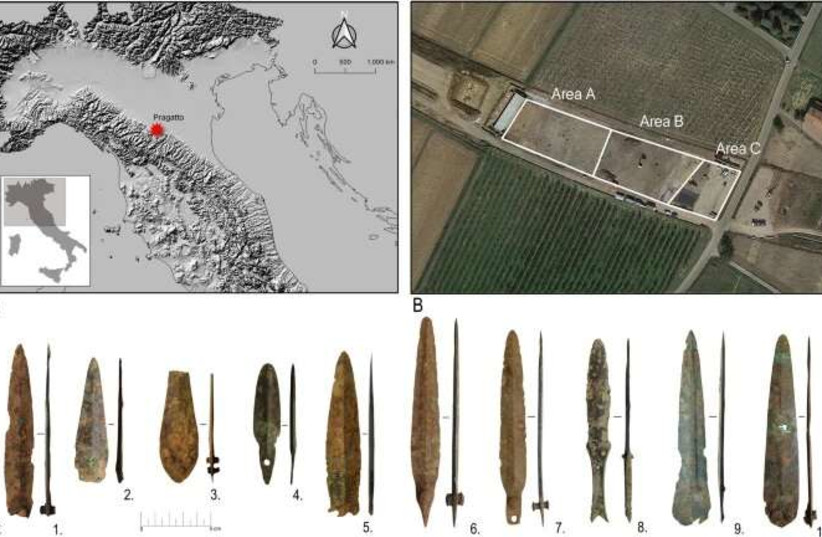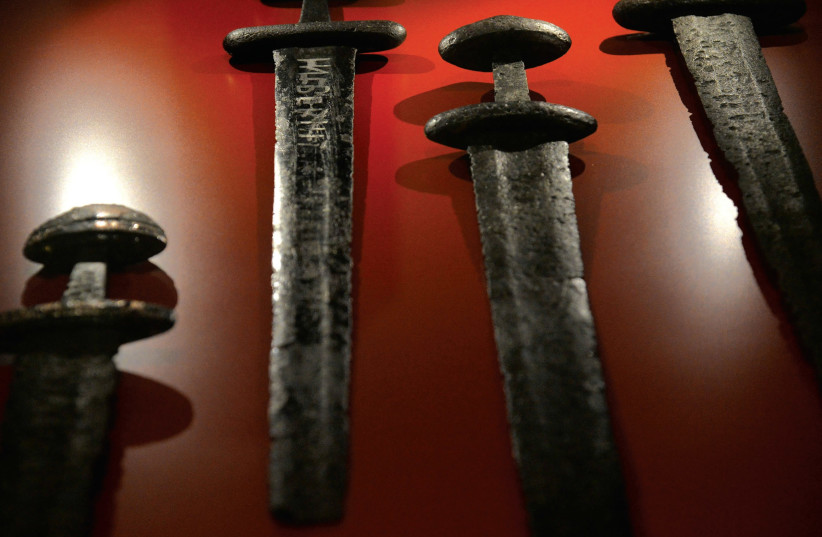What were Bronze Age daggers used for? New analysis method has answer
Long thought by many to have been used as a symbol of male identity and power, turns out they were used for something more mundane.

Used widely throughout Europe during the Bronze Age including the British Isles, the functional use of copper-alloy daggers has long been debated by researchers but until recently there had not been a scientific method to analyze the metal.
Now, an international research team led by Newcastle University in the northeast of England say they have solved the riddle by applying a pioneering analysis method.
In their report published in Scientific Reports, the researchers said they used a special staining solution to enable the world’s first extraction of organic residues from ten copper-alloy daggers excavated in 2017 from Pragatto, a Bronze Age settlement site in Italy.
The study included daggers with a broad range of blade shapes—including leaf shaped and triangular blades, lengths and methods of attachment to the handles, known as hafting. Chronologically, they span the period from 1550 to 1250 BCE.
Copper-alloy daggers first appeared in the early 4th millennium BCE, but unlike with artifacts made from other materials such as ceramic, stone and shell, there has not been a targeted method to analyze copper-alloy metals so the lack of scientific data what the daggers were used for remained an unsolved mystery.
Antique swords from ancient Israel. (credit: REUTERS)
Traditionally, they have been viewed as ceremonial symbols of male identity and power because many daggers were found in warrior burials, but other researchers had maintained that the daggers had multiple uses both as tools, perhaps for ritual slaughter of animals, and as weapons.
According to the researchers, the new analysis method revealed scientifically for the first time how these objects were used, for what tasks, and on what materials, and it seems to have been for the slaughtering, butchering and carving of animal livestock for meat.
They noted that daggers first appeared at about the same time in eastern and central Europe, the Alps, and the Italian peninsula in the early 4th millennium BCE, and were initially made from either flint or copper.
By the early 2nd millennium BCE, daggers were being made, used, and widely exchanged from Crete in the south to Scandinavia in the north, and from the Russian steppes in the east to Ireland in the west.
“After this cross-material floruit, flint and metal daggers parted ways, with the former all but disappearing from the archaeological record and the latter continuing to be made and used throughout the Bronze Age,” they wrote.
Led by Dr. Andrea Dolfini, Chair of Archaeology, Newcastle University, and Isabella Caricola, of the School of History, Classics and Archaeology at Newcastle University, the project team developed a technique using a Picro-Sirius Red (PSR) solution which is used to stain muscle and collagen fibers. Collagen is a fiber-like protein in the body which is used to make connective tissue.
The residues highlighted by the solution were then observed under optical, digital and scanning electron microscopes, which allowed the team to identify micro-residues of collagen and associated bone, muscle and bundle tendon fibers.
The researchers believe these findings suggest the daggers had indeed come into contact with multiple animal tissues and were used to process a variety of animal carcasses. The daggers seem to have been used for slaughtering of livestock, butchering carcasses and carving the meat from the bone, the researchers concluded.
In addition, the researchers had an expert bronze smith create exact replicas of the metal daggers, and carried out a wide set of experiments with them to help determine what they could have been used for, and also extracted biological residues from the experimental daggers. These were also analyzed and compared to the results from the archaeological daggers. The researchers determined that these types of daggers were well suited to the processing of animal carcasses.
“(This) is also in line with Pragatto being a settlement site where animal husbandry was extensively practiced… and our own experiments, which documented how effective these tools can be in detaching soft tissue from the bone,” they noted in their research.
But more important than just determining the use of the specific daggers they studied, the researchers say their results have proven the accuracy of their new process of analysis which can now be used for analysis of other copper-alloy tools and weapons.
“The research has revealed that it is possible to extract and characterize organic residues from ancient metals, extending the range of materials that can be analyzed in this way,” noted Dolfini, in a Newcastle University press release.
“This is a significant breakthrough as the new method enables the analysis of a wide variety of copper-alloy tools and weapons from anywhere in the world. The possibilities are endless, and so are the answers that the new method can and will provide in the future.”
THIS PAGE WAS POSTED BY SPUTNIK ONE OF THE SPUTNIKS ORBIT BLOG


No comments:
Post a Comment
Stick to the subject, NO religion, or Party politics